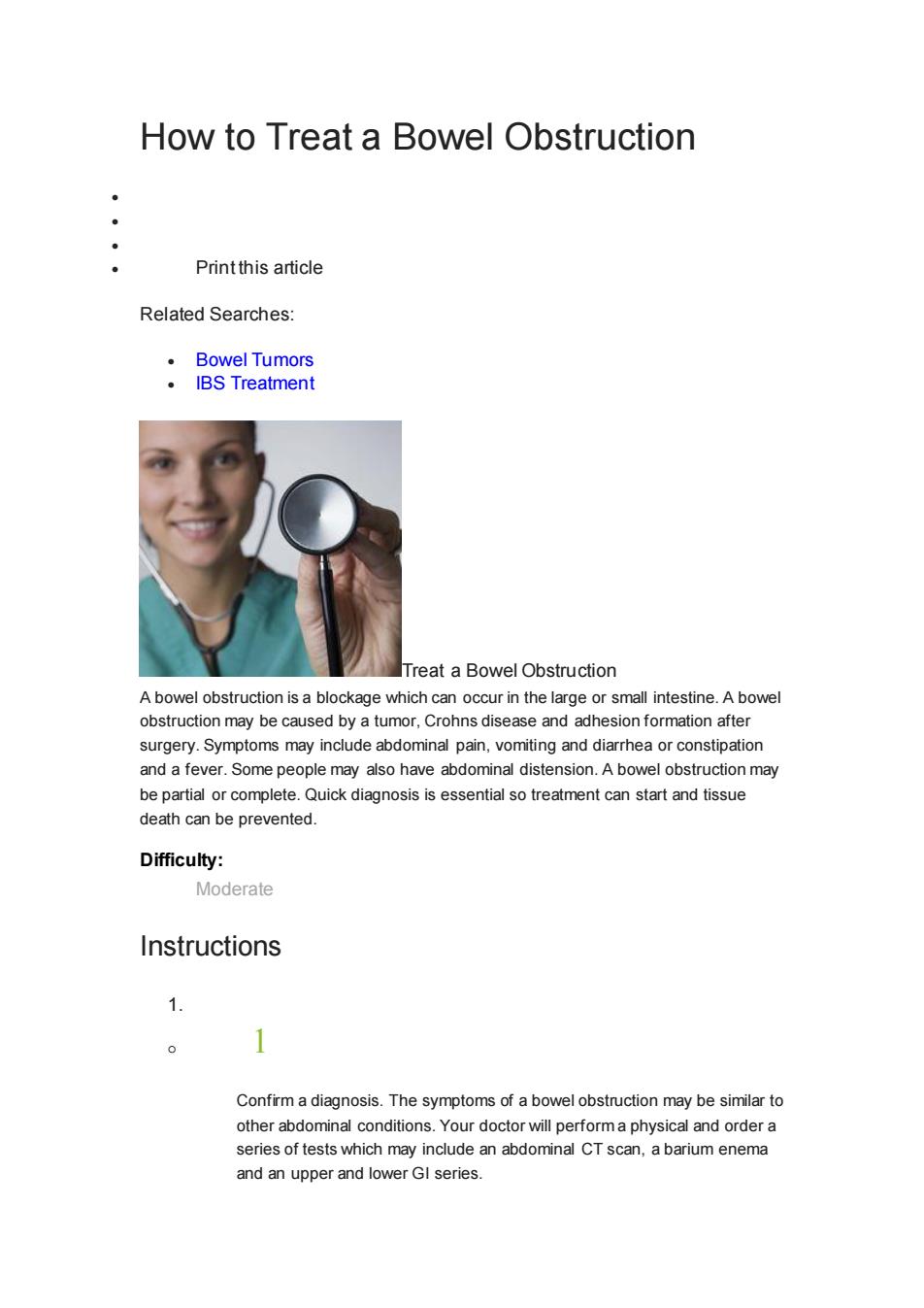
How to Treat a Bowel Obstruction Printthis article Related Searches: Treat a Bowel Obstruction A bowel obstruction is a blockage which can occur in the large or small intestine.A bowel obstruction may be caused by a tumor.Crohns disease and adhesion formation after surgery.Symptoms may include abdominal pain,vomiting and diarrhea or constipation and a fever.Some people may also have abdominal distension.A bowel obstruction may be partial or complete.Quick diagnosis is can start and tissue death can be preventec Difficulty Moderate Instructions 1. 1 Confirm a diagnosis.The symptoms of a bowel obstruction may be similar to can a barium enem and an upper and lower Gl series
How to Treat a Bowel Obstruction • • • • Print this article Related Searches: • Bowel Tumors • IBS Treatment Treat a Bowel Obstruction A bowel obstruction is a blockage which can occur in the large or small intestine. A bowel obstruction may be caused by a tumor, Crohns disease and adhesion formation after surgery. Symptoms may include abdominal pain, vomiting and diarrhea or constipation and a fever. Some people may also have abdominal distension. A bowel obstruction may be partial or complete. Quick diagnosis is essential so treatment can start and tissue death can be prevented. Difficulty: Moderate Instructions 1. o 1 Confirm a diagnosis. The symptoms of a bowel obstruction may be similar to other abdominal conditions. Your doctor will perform a physical and order a series of tests which may include an abdominal CT scan, a barium enema and an upper and lower GI series

2 Relieve abdominal distension.A nasogastric tube will be inserted into the stomach to decompress the intestine.The tube is able to remove any waste material which is above the blockage.This treatment tends to be used to treat a partial obstruction. 3 Undergo an endoscopy.This procedure may be used to treat an obstruction caused by a kinked intestine.A tube is inserted into the rectum and large intestine.It can be directed to the part of the bowel that is kinked and straighten it out. 4 Get intravenous fluids.Because vomiting and diarrhea are common symptoms of bowel obstruction.re-hydration through ivs can replace lost fluids and electrolytes. 5 Have surgery.Depending on the type of bowel obstruction a person has, mbendicated.bios comlnd pothis urgery will beneeded dead tissue 6 Take medications.Infection can occur as a result of a bowel obstruction. iwi ikeybe pribd tororprevent used to treat a bowel obstructio elievers and medications to stop vomiting. 7 Treat underlving medical conditions.Depending on the cause of a bowel hey can reoccur.To prevent further obstruction,seek treatment
o 2 Relieve abdominal distension. A nasogastric tube will be inserted into the stomach to decompress the intestine. The tube is able to remove any waste material which is above the blockage. This treatment tends to be used to treat a partial obstruction. o 3 Undergo an endoscopy. This procedure may be used to treat an obstruction caused by a kinked intestine. A tube is inserted into the rectum and large intestine. It can be directed to the part of the bowel that is kinked and straighten it out. o 4 Get intravenous fluids. Because vomiting and diarrhea are common symptoms of bowel obstruction, re-hydration through IV's can replace lost fluids and electrolytes. o 5 Have surgery. Depending on the type of bowel obstruction a person has, surgery may be indicated. If an obstruction is complete and part of the tissue has died, surgery will be needed to remove dead tissue. o 6 Take medications. Infection can occur as a result of a bowel obstruction. Antibiotics will likely be prescribed to treat or prevent an infection. Others medications used to treat a bowel obstruction include pain relievers and medications to stop vomiting. o 7 Treat underlying medical conditions. Depending on the cause of a bowel obstruction they can reoccur. To prevent further obstruction, seek treatment for Crohns disease, cancer and hernias